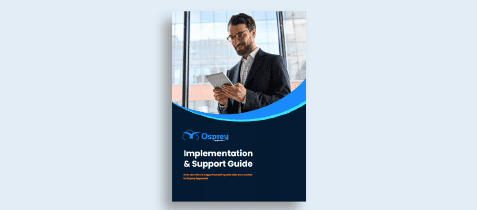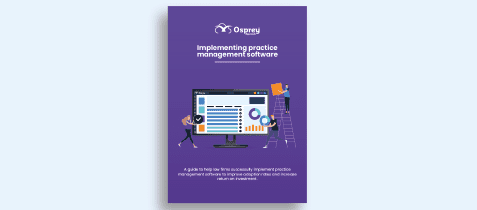Contents
A guide to legal software implementation: 6 FAQs answered
This article answers the six most frequently asked questions that we get from legal professionals who are looking to implement new practice and case management software. To help you choose the right solution for your law firm we cover timescales, costs, migrating data, and what to expect when implementing a case management system.

Implementing or migrating to a new case management system (CMS) is a time consuming and sometimes stressful project for law firms to undertake. To help make the process easier and to help you better prepare, we’ve answered the most common questions such as, how much it could cost your firm, if your data can be migrated from your existing system, and how long it’s likely to take to get fully up and running.
Answers to the 6 FAQs law firms ask before implementing new case management software
1. How long does it take to implement legal case management software into a law firm?
The time it takes to implement case management software varies depending on the size and complexity of your firm. Small law firms who have little data and few users can be set up very quickly due to minimal training and system configuration. But, on average, firms go live around three months after an agreement is signed.
There are a few things you can do to help speed up the implementation process:
- Have a person at your firm who will focus on the project as a priority
- Keep your team aware of the project and how it will affect them. Don’t forget to highlight the benefits too as this will help keep momentum across your firm, especially during training
- Review the data you’d like to migrate early in the process
A great way to implement the software quicker into your firm, and potentially minimise challenges, is to implement the software one department at a time. Some suppliers, such as Osprey, will offer a phased case management approach to help your firm effectively manage the change.
Guidance on how long case management software implementations take >
2. How much does it cost to switch to a new case management system?
The costs of switching to new case management software is dependent on various factors and all software suppliers provide different services and methods. So this will be specific to your chosen software partner. To reap the benefits of your next software investment, it’s important to choose the software and provider that’s right for your firm’s needs. Osprey ensures implementation costs aren’t a barrier to getting started, so we don’t require any upfront costs when switching to Osprey. Any implementation or data migration costs are spread across your monthly payments. In addition, Osprey also provides all-inclusive and unlimited training and telephone-first support so all employees can continue to make the most from the software.
Discover the factors that affect the cost of legal software implementation >
3. Can we move our data and documents from our existing legal software to the new system?
Your current provider should be able to make a backup of your existing data available. For most systems it’s fairly simple to extract the necessary data ready for importing into the new system. Sometimes the data needs reformatting, or custom fields created and configured into the new system, but typically your data can be successfully migrated.
Throughout the planning stages of your implementation of Osprey, your project manager and data expert will assist and advise on what data you should migrate, how to cleanse it so you can get the most out of the new system, and provide you with a structure for how it will need to be imported to guarantee it’s effective once transferred.
The move to a new system is an opportune time to cleanse and refresh your data to ensure you’re working with the best information. The better quality data you input into your legal software, the better results it can provide you. We recommend reviewing the data you currently hold and only importing data that needs to be retained rather than all historical data.
Learn the six steps you can take to simplify your law firm’s data migration >
4. How do we implement new legal software?
Every software supplier’s implementation process is different. This is normally discussed at proposal stage and then outlined again in more detail before the project begins.
A typical implementation processes has six stages:
- Welcome session – It’s here where you’ll meet the implementation team. They will outline the key project stages and start discussing options for migrating data and go-live dates.
- Existing process review – Your Osprey project manager will shadow your teams, across all departments to fully understand your current operations and how you use your existing software. This helps us configure Osprey to your needs, tailor training sessions, and recommend process improvements to better meet your goals.
- Project planning meeting – This is typically a full day meeting to define the project plan and scope, along with the data migration plan, system configuration details, and the training schedule.
- System configuration – Using the data gathered during the project planning stage your new system will be set up for your firm.
- Migrating your data – The data migration team will work alongside you to format your data. Osprey starts with test samples to ensure accuracy and if discrepancies are found the data is reviewed and retested and the process starts again.
- Training – Usually taking place whilst the system is getting set up and the data is being migrated, your team will follow a role-based training programme to understand the fundamentals of the new system. Training is also available and encouraged post implementation at no additional cost. You can book online training or trainer-led courses at a time that suits you.
- Go-live day – The final step in the project where you’ll have priority access to the support team during your go-live to ensure the launch is a success.
If you would like to learn more about the Osprey tried and tested process, you can find more information in our Implementation and Support guide.
5. Do legal software providers offer training?
Most legal software providers offer training on the system, but not all training programmes are created equally. To increase the return on your software investment, and ensure the firm is reaping the benefits the software can provide, it’s important that your employees are confident users of the system. The software is only as good as the individuals using them.
We recognise it can be hard to balance software training and billable hours, but your team will be better equipped to utilise the system to their advantage if training is taken upfront. To help you find the time we recommend scheduling the sessions in advance so they’re already in the diary, communicating the benefits of the software to the team so they know the value it can bring, and making use of multi-channel training to fit better into everyone’s schedule.
Most software providers deliver a basic level training but it’s important to ask who hosts the sessions – is it a third-party provider? How often can we take training? And will training be offered after go-live and at what cost?
Osprey offers all inclusive, unlimited training. All users will have access to online interactive courses, trainer led one-to-one or group sessions, how-to guide, and training videos. All our training is delivered in-house by our UK team of Osprey experts so they’re able to provide best practices and further advice on getting the most from the software.
6. What happens if something goes wrong during the legal software implementation process?
Sometimes, things don’t always go to plan, But, during all stages of the project – especially during the planning stages – your software supplier should have quality controls in place that help to minimise any disruption. The project planning sessions are there not only to define the schedule but to highlight any areas that could cause problems and delays and to set a plan to mitigate risk.
Go live day should be a celebration of the new software and the benefits it’ll bring to your firm, so your project manager will help and guide you through every step of the way to minimise disruption and provide support. For Osprey customers, every user has access to telephone-first support from our UK-based support team, that are on-hand between 8.30am to 6.30 pm, Monday to Friday. So the team are always there to support and guide you, even after go-live day.
Remove the guesswork from your next legal software implementation
While software implementation projects can feel like a big undertaking for your firm, being fully prepared for the project can help to better manage the change so you can start reaping the rewards from day one.
Having a hands-on, fully supportive software partner is important for successfully implementing new software. That’s why, at Osprey, our tired and tested implementation process aims to mitigate unforeseen challenges, minimise stress across the team, and importantly provide best practices and advice to utilising the software for your firm’s specific needs.
Confidently make the switch to Osprey Approach. Find out more about our all-inclusive role-based training programmes, telephone-first support, and ongoing success support today.
Find out if Osprey Approach is the right solution for your law firm and book a free consultation today with our product experts and discover the financial benefits for your law firm.
For more information on implementing legal software at your law firm, check out all parts of our legal implementation guide:
Part 2 – 7 factors that impact the length of software implementation
Part 3 – How to simplify data migration
Part 4 – How much does legal software cost?
Part 5 – How to effectively train your staff




